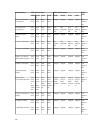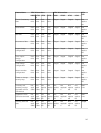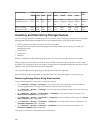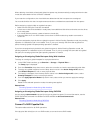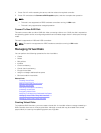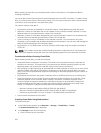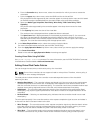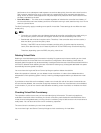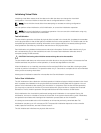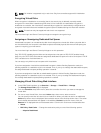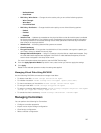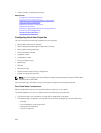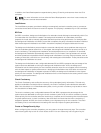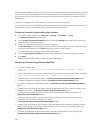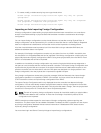
performance since subsequent read requests can retrieve data quickly from the cache then from the
disk. However, data loss may occur in the event of a system failure which prevents that data from
being written on a disk. Other applications may also experience problems when actions assume that
the data is available on the disk.
• Force Write Back — The write cache is enabled regardless of whether the controller has a battery. If
the controller does not have a battery and force write back caching is used, data loss may occur in the
event of a power failure.
The Disk Cache policy apply to readings on a specific virtual disk. These settings do not affect the read-
ahead policy.
NOTE:
• Controller non-volatile cache and battery backup of controller cache affects the read-policy or
the write policy that a controller can support. All PERCs do not have battery and cache.
• Read ahead and write back requires cache. Therefore, if the controller does not have cache, it
does not allow you to set the policy value.
Similarly, if the PERC has cache but not battery and the policy is set that requires accessing
cache, then data loss may occur if base of power off. So few PERCs may not allow that policy.
Therefore, depending upon the PERC, the policy value is set.
Deleting Virtual Disks
Deleting a virtual disk destroys all information including file systems and volumes residing on the virtual
disk and removes the virtual disk from the controller’s configuration. When deleting virtual disks, all
assigned global hot spares may be automatically unassigned when the last virtual disk associated with the
controller is deleted. When deleting the last virtual disk of a disk group, all assigned dedicated hot spares
automatically become global hot spares.
You must have the Login and Server Control privilege to perform delete virtual disks.
When this operation is allowed, you can delete a boot virtual drive. It is done from sideband and the
independent of the operating system. Hence, a warning message appears before you delete the virtual
drive.
If you delete a virtual disk and immediately create a new virtual disk with all the same characteristics as
the one that was deleted, the controller recognizes the data as if the first virtual disk were never deleted.
In this situation, if you do not want the old data after recreating a new virtual disk, re-initialize the virtual
disk.
Checking Virtual Disk Consistency
This operation verifies the accuracy of the redundant (parity) information. This task only applies to
redundant virtual disks. When necessary, the check consistency task rebuilds the redundant data. If the
virtual drive has a degraded status, running a check consistency may be able to return the virtual drive to
ready status. You can also cancel the check consistency operation.
The cancel check consistency is a real-time operation.
You must have Login and Server Control privilege to check consistency of virtual disks.
224



